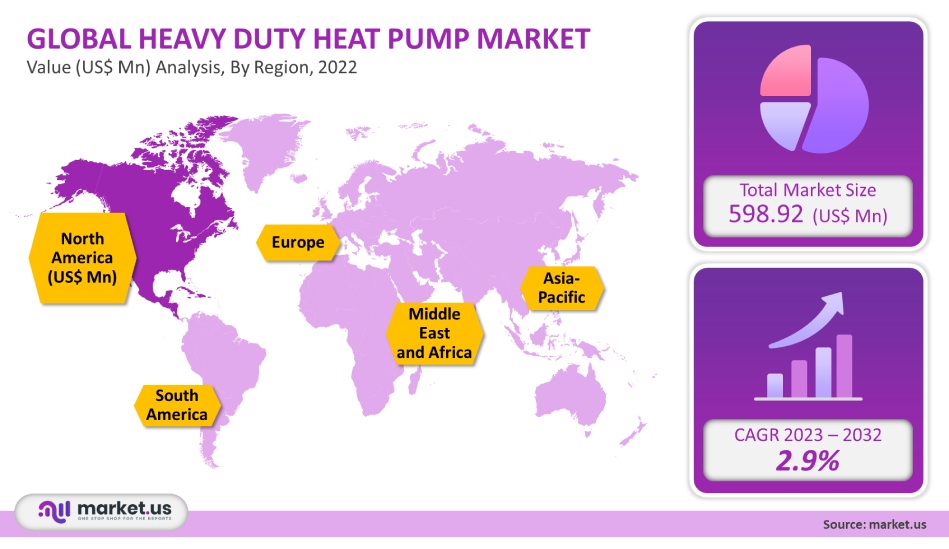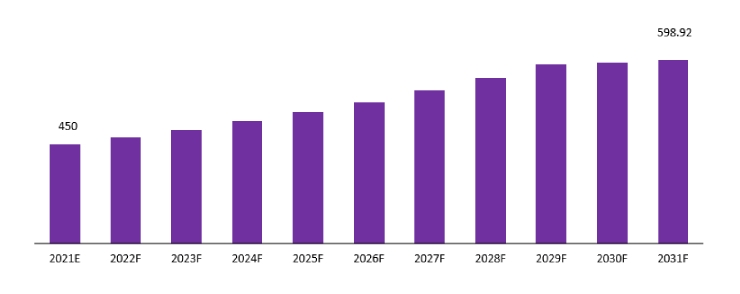Global Heavy Duty Heat Pump Market, by Product Types (Air-water Heat Pump, Air-air Heat Pump, Ground Source Heat Pump, Hybrid Heat Pump) by Power Source (Electric, Gas Driven), By System Type (Air Source Heat Pump, Geothermal Heat Pump, Absorption Heat Pump), , By Power Range (5 to 10MW, 10 to 20MW, 20 to 40MW), By End-Use (Residential, Commercial, Industrial), and by Region and Companies - Industry Segment Outlook, Market Assessment, Competition Scenario, Trends and Forecast 2022-2032
- Published date: May 2023
- Report ID: 84441
- Number of Pages: 202
- Format:
- keyboard_arrow_up
Quick Navigation
- Heavy Duty Heat Pump Маrkеt Overview
- Global Heavy Duty Heat Pump Market Revenue (US$ Mn), 2021–2031
- The Global Heavy Duty Heat Pump Market Segmentation is Based on Product Types, Power Source, System Type, Refrigerant Type, Power Range, End-Use, and Region
- The research report on the global heavy-duty heat pump market includes major company profiles such as
Heavy Duty Heat Pump Маrkеt Overview
The global heavy-duty heat pump market is projected to reach USD 598.92 Mn by 2031 at a CAGR of 2.9%, from USD 450 Mn in 2021.
“Global Heavy Duty Heat Pump Market, by Product Types (Air-water Heat Pump, Air-air Heat Pump, Ground Source Heat Pump, Hybrid Heat Pump) by Power Source (Electric, Gas Driven), By System Type (Air Source Heat Pump, Geothermal Heat Pump, Absorption Heat Pump), by Refrigerant Type (HFC, CO2, Ammonia, Hydrocarbons, Other Refrigerant Types), By Power Range (5 to 10MW, 10 to 20MW, 20 to 40MW), By End-Use (Residential, Commercial, Industrial), and by Region – Global Forecast to 2031”. This report offers a holistic view of the global heavy-duty heat pump market through systematic segmentation that covers every aspect of this target market.
A heat pump is an air-conditioning system that takes heat from outdoor air and converts it to cool an indoor area. Heavy-duty heat pumps vary from conventional pump units in that they are designed for commercial and residential air conditioning. They also offer a greater capacity for heating, with temperatures up to 200°F.
Heavy-duty heat pumps save energy consumption and reduce a user’s carbon footprint. Heavy-duty heat pumps are more efficient than standard heating and cooling units because they take in air and use it for heating and cooling. Standard models rely on electricity or gas, which can be costly. Additionally, these pumps require lesser maintenance since they don’t require water.

Heavy-duty heat pumps are the perfect solution for businesses that require large units to operate or maintain indoor temperatures. These units are generally used in warehouses, factories, and other facilities where several employees work. A heavy-duty unit should be able to handle up to 10 tons of cooling capacity and deliver up to 30 tons of heating capacity. Heavy-duty pumps will greatly reduce energy costs by using less electricity during operation. A heat pump is a great way to produce efficient heat in the winter and cool air in the summer months. If you own a home or small business, a heat pump can help save on energy costs while offering reliable comfort all year round. There are two types of heat pumps: one that moves heat from outdoors inside called an ‘air-source’ heat pump, and one that moves heat from indoors – out, called an ‘electric-source’ or ‘geothermal’ heat pump.
A heavy-duty heat pump is a machine that moves heat from the inside of a building to the outside or vice-versa. A pump’s efficiency varies depending on the temperature difference between indoor and outdoor air. It also depends on the type of insulation and the room size. This type of heat pump can work in temperatures as low as -15°F (-26°C), and the inside air temperature can be up to 80°F (27°C). It can be powered by natural gas, propane, electric, or solar. A heat pump uses a refrigeration cycle to extract heat from the outside air and move it indoors.
Global Heavy Duty Heat Pump Market Revenue (US$ Mn), 2021–2031

Source: Prudour, 2021
Sales are expected to increase as the demand for ground source heating pumps increases in central buildings’ cooling and heating systems in the business sector. Concerns about climate change and the necessity for cooling and heating systems have spurred the stipulation for heavy-duty heat pumps in both commercial and residential sectors. Other factors that may help to augment this market are, reduced carbon dioxide emissions, higher energy efficiency, and the expansion of commercial areas around the world.
The soaring demand for sustainable solutions in heating and cooling systems and increased research & development activities are creating profitable opportunities for new product development to meet evolving end-user requirements. These factors are expected to create lucrative opportunities for existing and emerging players in this market.
Mitsubishi Heavy Industries Thermal Systems Ltd., a subsidiary of Mitsubishi Heavy Industries Group, revamped all 17 models in its KXZ series of building-use inverter multi-split air conditioners for their global introduction on May 13, 2021.
Philip Doyle Manufacturing, a Canadian manufacturer of heavy-duty air conditioning systems, adopted Honeywell’s Solstice N15 (R515B) refrigerant designed for R134a and R124 in chillers and heat pumps in October 2020.
In October 2020, Johnson Controls, a global solutions provider for smart and sustainable buildings, introduced a high-efficiency pleated air filter as an alternative to costly HEPA filtering upgrades.
The Global Heavy Duty Heat Pump Market Segmentation is Based on Product Types, Power Source, System Type, Refrigerant Type, Power Range, End-Use, and Region
Based on Product Types
- Air-Water Heat Pumps
- Air-Air Heat Pumps
- Ground Source Heat Pumps
- Hybrid Heat Pumps
Based on Power Source
- Electric
- Gas-Driven
Based on System Type
- Air Source Heat Pumps
- Geothermal Heat Pumps
- Absorption Heat Pumps
Based on Refrigerant Type
- HFC
- CO2
- Ammonia
- Hydrocarbons
- Other Refrigerant Types
Based on Power Range
- 5 to 10MW
- 10 to 20MW
- 20 to 40MW
Based on End-Use
- Residential
- Commercial
- Industrial
Based on Region
- North America
- Europe
- Asia-Pacific
- South America
- Middle East & Africa
The research report on the global heavy-duty heat pump market includes major company profiles such as
- Thermax Ltd.
- Star Refrigeration
- GEA Group
- MAN Energy Solutions
- Oilon OY
- Siemens Energy
- Johnson Controls
- Friotherm AG
- Engie Refrigeration GmbH
- Daikin Industries
- Enertech AB
- Mitsubishi Heavy Industries, among others.
For the Heavy Duty Heat Pump Маrkеt research study, the following years have been considered to estimate the market size:
Attribute Report Details Historical Years
2016-2020
Base Year
2021
Estimated Year
2022
Short Term Projection Year
2028
Projected Year
2023
Long Term Projection Year
2032
Report Coverage
Competitive Landscape, Revenue analysis, Company Share Analysis, Manufacturers Analysis, Volume by Manufacturers, Key Segments, Key company analysis, Market Trends, Distribution Channel, Market Dynamics, COVID-19 Impact Analysis, strategy for existing players to grab maximum market share, and more.
Regional Scope
North America, Europe, Asia-Pacific, South America, Middle East & Africa
Country Scope
United States, Canada and Mexico, Germany, France, UK, Russia and Italy, China, Japan, Korea, India and Southeast Asia, Brazil, Argentina, Colombia etc.Saudi Arabia, UAE, Egypt, Nigeria and South Africa
 Heavy Duty Heat Pump МаrkеtPublished date: May 2023add_shopping_cartBuy Now get_appDownload Sample
Heavy Duty Heat Pump МаrkеtPublished date: May 2023add_shopping_cartBuy Now get_appDownload Sample - Thermax Ltd.
- Star Refrigeration
- GEA Group (Bock Gmbh) Company Profile
- MAN Energy Solutions
- Oilon OY
- Siemens Energy
- Johnson Controls
- Friotherm AG
- Engie Refrigeration GmbH
- Daikin Industries Ltd. Company Profile
- Enertech AB
- Mitsubishi Heavy Industries, among others.
- settingsSettings
Our Clients
| Single User $4,599 $3,499 USD / per unit save 24% | Multi User $5,999 $4,299 USD / per unit save 28% | Corporate User $7,299 $4,999 USD / per unit save 32% | |
|---|---|---|---|
| e-Access | |||
| Report Library Access | |||
| Data Set (Excel) | |||
| Company Profile Library Access | |||
| Interactive Dashboard | |||
| Free Custumization | No | up to 10 hrs work | up to 30 hrs work |
| Accessibility | 1 User | 2-5 User | Unlimited |
| Analyst Support | up to 20 hrs | up to 40 hrs | up to 50 hrs |
| Benefit | Up to 20% off on next purchase | Up to 25% off on next purchase | Up to 30% off on next purchase |
| Buy Now ($ 3,499) | Buy Now ($ 4,299) | Buy Now ($ 4,999) |










